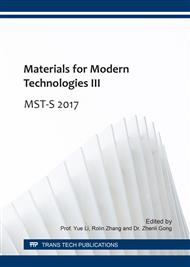p.9
p.13
p.18
p.26
p.32
p.40
p.47
p.57
p.62
Graphene Oxide PMMA Solid on the Absorption of Lead Ion
Abstract:
GO-PMMA solid was used to test its ability on absorbing the lead ion obtained from standard solution. Samples of the test solution were collected at 0 min, 10 min, 30 min, 50 min and 70 min. The results analyzed from ICP reveal that GO-PMMA solid could absorb lead (II) ion sup to 68.6%, which is 65.8% higher than the control setup, i.e. PMMA solid, at room temperature and pressure. The dry mass of GO-PMMA solid is around 119.82g and the mass after testing is around 124.21g. The ability of absorption could be easily refreshed by washing with ethanol and distillated water (80/20 v/v) several times. Structure of GO-PMMA solid was characterized by FRIR and optical microscope. The oxygen-containing functional groups and the rough surface of the GO-PMMA solid are determined to be the contributing factors of the adsorption of lead (II) ion onto GO-PMMA solid. The high removal efficiency of GO-PMMA suggests its adsorption capability on lead (II) ion and can be applied to remove lead (II) ions from water.
Info:
Periodical:
Pages:
32-39
Citation:
Online since:
March 2017
Authors:
Keywords:
Price:
Сopyright:
© 2017 Trans Tech Publications Ltd. All Rights Reserved
Share:
Citation:


